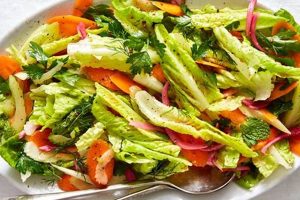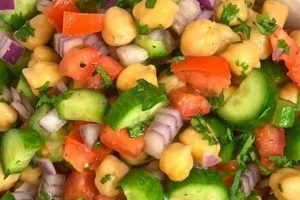Combinations of fresh figs with complementary ingredients like cheeses, nuts, and leafy greens, often enhanced by a vinaigrette, constitute a versatile culinary creation. A simple example might include quartered figs, crumbled goat cheese, toasted walnuts, and baby spinach, dressed with a balsamic glaze.
These dishes offer a balance of sweet and savory flavors, providing nutritional benefits from the fruit’s fiber, vitamins, and antioxidants, alongside other healthful components. Historically, figs have been cultivated and consumed for millennia, appearing in various cuisines worldwide. Their inclusion in salads elevates a simple dish, adding a touch of elegance and a unique flavor profile.
Further exploration will delve into specific formulations, variations, and techniques for creating these delightful culinary experiences, from selecting the perfect figs to crafting complementary dressings and pairings.
Tips for Crafting Exceptional Fig Salads
Creating a balanced and flavorful combination requires attention to detail and an understanding of complementary ingredients. The following tips offer guidance for achieving optimal results.
Tip 1: Fig Selection: Opt for ripe, but not overripe, figs. Ripe figs yield slightly to gentle pressure and offer a fragrant aroma. Avoid figs that are bruised or leaking.
Tip 2: Balancing Flavors: Consider the interplay of sweet, savory, and acidic elements. Pair figs with cheeses like goat cheese, blue cheese, or ricotta salata. Nuts such as walnuts, pecans, or pistachios provide textural contrast and complementary flavors.
Tip 3: Greens Selection: Choose greens that complement the other ingredients. Baby spinach, arugula, or mixed greens offer a delicate backdrop, while heartier greens like kale can provide a robust counterpoint.
Tip 4: Dressing Choices: A simple vinaigrette often enhances the flavors. Balsamic glaze, honey-mustard dressing, or a light citrus vinaigrette provide harmonious acidity and sweetness.
Tip 5: Ingredient Preparation: Wash and dry greens thoroughly. Toast nuts lightly to enhance their flavor. Figs can be quartered, halved, or sliced depending on preference and the other ingredients.
Tip 6: Assembly and Presentation: Arrange ingredients thoughtfully on a platter or individual plates. Consider the visual appeal of color and texture. A sprinkle of fresh herbs, such as mint or thyme, can provide a final flourish.
Tip 7: Seasonality: Utilize seasonal ingredients whenever possible. This ensures optimal flavor and freshness.
By following these guidelines, one can create a dish that showcases the unique qualities of figs while offering a delightful culinary experience.
These tips provide a foundation for crafting successful fig-based salads. Experimentation with different flavor combinations and presentations is encouraged.
1. Fresh, Ripe Figs
The foundation of any successful fig salad rests upon the quality of its core ingredient: fresh, ripe figs. Selecting and utilizing figs at their peak ripeness is paramount for achieving optimal flavor and texture. This section explores key facets of fig selection and their impact on the overall dish.
- Ripeness Indicators:
Determining ripeness involves several sensory cues. A ripe fig yields slightly to gentle pressure, exhibiting a soft, plump texture. The skin color deepens depending on the variety, ranging from deep purple to golden brown. A subtle, sweet aroma emanates from the stem area. Avoiding overly soft, bruised, or leaking figs is crucial, as these indicate overripeness or spoilage, potentially compromising the salad’s flavor and aesthetics.
- Flavor Profile:
Ripe figs offer a complex sweetness balanced by subtle earthy notes. The flavor intensity varies among varieties, with some exhibiting honeyed nuances, while others possess a more robust, berry-like character. This inherent sweetness plays a crucial role in the overall flavor balance of the salad, complementing savory elements such as cheeses and nuts, and providing a counterpoint to acidic vinaigrettes.
- Textural Contribution:
The texture of a ripe fig is delicate yet substantial. Its soft flesh provides a pleasant contrast to crisp greens and crunchy nuts. The skin, while edible, can sometimes be slightly tougher, particularly in less ripe specimens. Properly ripened figs offer a melt-in-your-mouth quality that enhances the overall sensory experience of the salad.
- Variety Considerations:
Numerous fig varieties exist, each possessing unique characteristics. Black Mission figs, with their deep purple skin and rich flavor, are a popular choice. Brown Turkey figs offer a milder sweetness, while Calimyrna figs, known for their golden skin and nutty flavor, provide a distinct profile. The chosen variety influences the salad’s overall taste and visual appeal.
The selection of fresh, ripe figs directly impacts the overall quality and enjoyment of a fig salad. Careful consideration of ripeness indicators, flavor profiles, textural contributions, and varietal characteristics ensures a harmonious balance of flavors and textures, resulting in a truly exceptional culinary experience.
2. Complementary Cheeses
The success of a fig salad often hinges on the judicious selection of cheeses that complement the fig’s sweetness and delicate texture. Cheese provides a crucial counterpoint, adding savory notes, creamy textures, and aromatic complexity. This careful pairing elevates the salad from simple to sophisticated.
- Flavor Pairing:
Figs possess a distinct sweetness with subtle earthy undertones. Cheeses with pronounced savory or salty characteristics create a balanced flavor profile. Examples include pungent blue cheeses like Roquefort or Gorgonzola, which offer a sharp contrast to the fig’s sweetness. Alternatively, tangy goat cheese provides a brighter, more acidic counterpoint. The interplay of these contrasting flavors creates a dynamic and engaging culinary experience.
- Textural Contrast:
The soft, yielding texture of ripe figs benefits from the addition of cheeses with varying textures. Crumbled feta or goat cheese introduces a pleasant crumbliness, while creamy cheeses like ricotta or mascarpone offer a smooth, luxurious contrast. Hard cheeses, such as shaved Parmesan or Pecorino, contribute a firm bite. This textural diversity prevents the salad from becoming monotonous and adds another layer of sensory enjoyment.
- Aromatic Complexity:
Cheeses contribute not only flavor and texture but also aromatic complexity. The earthy aroma of a washed-rind cheese or the pungent scent of a blue cheese interacts with the delicate fragrance of the figs, creating a more nuanced and captivating olfactory experience. This interplay of aromas elevates the overall sensory perception of the dish.
- Visual Appeal:
The visual presentation of cheese in a fig salad contributes to its overall appeal. The stark white of feta against the deep purple of a Black Mission fig creates a striking contrast. The blue veining in Gorgonzola adds visual interest, while the creamy texture of ricotta provides a smooth, elegant touch. These visual elements enhance the dining experience and contribute to the salad’s aesthetic appeal.
The careful consideration of cheese selection in a fig salad is essential for achieving a harmonious balance of flavors, textures, and aromas. The interplay between the fig’s natural sweetness and the chosen cheese’s characteristics elevates the salad from a simple combination of ingredients to a complex and satisfying culinary creation.
3. Crunchy Nuts/Seeds
The incorporation of crunchy nuts and seeds into fig salads provides more than just textural contrast; it contributes a crucial layer of flavor complexity and nutritional value. Nuts and seeds offer a counterpoint to the fig’s sweetness and soft texture, enhancing the overall sensory experience. Their presence elevates the salad from a simple combination of ingredients to a more sophisticated and satisfying dish.
The selection of nuts and seeds should consider both flavor and texture. Walnuts, with their slightly bitter and earthy notes, complement the fig’s sweetness exceptionally well. Pecans offer a buttery richness, while pistachios contribute a subtle saltiness and vibrant green hue. Seeds, such as toasted pumpkin or sunflower seeds, provide a lighter crunch and nutty flavor. Consider a candied pecan or walnut for enhanced sweetness. These additions introduce textural variation, preventing the salad from feeling one-dimensional. The interplay of soft figs, crisp greens, and crunchy nuts creates a dynamic and engaging mouthfeel.
Beyond their sensory contributions, nuts and seeds offer significant nutritional benefits. They are rich in healthy fats, fiber, protein, and essential minerals, aligning with the overall health-conscious nature of fig salads. The combination of fruit, nuts, and seeds results in a dish that is not only delicious but also nutrient-dense. However, portion control remains important, as nuts and seeds are calorically dense. A moderate amount provides optimal flavor and nutritional enhancement without compromising dietary goals. Understanding the role of crunchy nuts and seeds allows for informed ingredient selection and portioning, ensuring a balanced and satisfying culinary experience.
4. Balanced Vinaigrette
A balanced vinaigrette is crucial for a successful fig salad recipe. It provides acidity to cut through the sweetness of the figs and richness of accompanying ingredients like cheese and nuts. The vinaigrette acts as a unifying element, binding the diverse flavors and textures while enhancing the overall sensory experience. A poorly conceived dressing can easily overpower the delicate flavors of the figs, while a well-crafted one elevates the entire dish.
- Acidity:
Acidity is the backbone of a vinaigrette. It provides the necessary brightness to balance the sweetness of the figs. Common acidic components include vinegar (balsamic, red wine, apple cider) and citrus juices (lemon, lime, orange). The level of acidity should be carefully calibrated to complement, not overwhelm, the other ingredients. For example, a balsamic vinaigrette with a touch of honey can provide a balanced sweet-and-sour profile that harmonizes with the figs.
- Oil:
Oil provides richness and mouthfeel to the vinaigrette. Extra virgin olive oil is a classic choice, offering a fruity flavor that complements the figs. Other oils like walnut or avocado oil can also be used, adding their unique flavor profiles. The ratio of oil to acid determines the vinaigrette’s overall texture and richness. A standard ratio is 3:1 (oil to acid), but this can be adjusted based on personal preference and the specific salad components.
- Sweetness:
A touch of sweetness in the vinaigrette can further enhance the flavor balance. Honey, maple syrup, or a pinch of sugar can be used to temper the acidity and create a more nuanced flavor profile. This sweetness should be subtle, allowing the natural sweetness of the figs to shine through. For example, a balsamic vinaigrette with a drizzle of honey complements the fig’s sweetness without being overly sugary.
- Seasoning:
Proper seasoning is essential for any vinaigrette. Salt and freshly ground black pepper are fundamental, enhancing the other flavors and providing depth. Other seasonings, like Dijon mustard, minced garlic, or herbs (fresh or dried), can add complexity and personalize the vinaigrette. The key is to season judiciously, allowing the natural flavors of the figs and other ingredients to take center stage.
A well-balanced vinaigrette ties all the elements of a fig salad together. The interplay of acidity, oil, sweetness, and seasoning creates a harmonious flavor profile that enhances the figs and other ingredients. The vinaigrette not only adds flavor but also contributes to the overall texture and visual appeal of the salad, making it a crucial component of a successful fig salad recipe.
5. Leafy greens/herbs
Leafy greens and herbs play a vital role in fig salad recipes, contributing texture, flavor, and visual appeal. Their inclusion elevates the salad beyond the core ingredients, creating a more complex and satisfying sensory experience. The choice of greens and herbs significantly influences the final product’s overall character.
Leafy greens provide a foundation of freshness and contribute varied textures. Delicate greens like baby spinach and arugula offer a soft counterpoint to the fig’s chewiness, while more robust greens like kale or romaine lettuce introduce a satisfying crunch. The peppery bite of arugula can balance the fig’s sweetness, while the mildness of spinach allows the other flavors to shine. Watercress adds a peppery, slightly bitter note that complements the sweetness of ripe figs. Heartier greens, like radicchio, can introduce a contrasting bitterness. The selection of greens should consider the overall flavor profile desired.
Fresh herbs contribute aromatic complexity and nuanced flavors. Mint provides a refreshing coolness, while basil offers a subtle anise-like sweetness. Tarragon introduces a slightly licorice-like flavor, and thyme contributes earthy notes. Chives offer a mild onion flavor. The choice of herbs can significantly influence the final salad’s overall taste. For example, a fig salad with prosciutto and goat cheese might benefit from the peppery bite of arugula and the refreshing coolness of mint, while a salad with walnuts and blue cheese could be enhanced by the earthiness of thyme or the subtle anise notes of basil.
The combined use of leafy greens and herbs not only adds flavor and texture but also enhances the visual presentation. The vibrant green hues of various greens, combined with the varied textures and colors of herbs, create an aesthetically pleasing dish. This visual appeal adds to the overall dining experience. Skillful selection and application of leafy greens and herbs are crucial for achieving a well-balanced and appealing fig salad. The interplay of textures, flavors, and visual elements elevates the dish, creating a more sophisticated and satisfying culinary experience.
6. Seasonal Variations
Seasonal variations significantly impact fig salad recipes, influencing ingredient availability, flavor profiles, and overall culinary experience. Adapting to seasonal produce allows for the creation of dynamic and harmonious salads that showcase the best of each season’s offerings. Exploring these variations provides a deeper understanding of how seasonality enhances fig salad composition.
- Spring Salads:
Spring fig salads emphasize fresh, bright flavors. Newly ripened figs pair well with young greens like spinach or arugula. Citrus fruits, such as oranges or grapefruits, provide a refreshing acidity. Toasted almonds or pistachios offer complementary crunch and subtle sweetness. A light vinaigrette with lemon juice and honey enhances the spring flavors without overpowering the delicate ingredients.
- Summer Salads:
Summer offers an abundance of ripe figs and vibrant produce. Pair figs with heirloom tomatoes, cucumbers, and fresh herbs like basil or mint. Feta or goat cheese adds a tangy, salty element. A simple vinaigrette with balsamic vinegar and olive oil complements the summery flavors. Grilled halloumi cheese adds a smoky dimension.
- Autumn Salads:
Autumn fig salads embrace richer, earthier flavors. Figs pair well with roasted root vegetables like beets or sweet potatoes. Nuts like walnuts or pecans provide a satisfying crunch. Blue cheese or Gorgonzola offer a pungent counterpoint to the fig’s sweetness. A maple-balsamic vinaigrette enhances the autumnal flavors.
- Winter Salads:
Winter fig salads often incorporate dried or preserved figs, offering a concentrated sweetness. Pair them with winter greens like kale or radicchio. Toasted walnuts or pecans add warmth and texture. Crumbled goat cheese or shaved Parmesan provide a savory element. A citrus vinaigrette with orange or grapefruit brightens the winter flavors. Adding pomegranate seeds provides a burst of juicy sweetness and a festive touch.
By embracing seasonal variations, fig salads evolve beyond static recipes, transforming into dynamic culinary expressions that reflect the unique characteristics of each season. This adaptability ensures not only optimal flavor but also a deeper appreciation for the interconnectedness of food and the natural world. The exploration of seasonal variations provides a pathway to crafting fig salads that are both delicious and reflective of the time of year.
Frequently Asked Questions
This section addresses common inquiries regarding the creation and enjoyment of fig salads.
Question 1: How to select ripe figs for a salad?
Ripe figs yield slightly to gentle pressure and exhibit a fragrant aroma. Avoid figs that are bruised, leaking, or overly soft.
Question 2: What cheeses pair well with figs in a salad?
Cheeses with contrasting flavors and textures complement figs. Goat cheese, blue cheese, feta, ricotta salata, and Parmesan are excellent choices.
Question 3: Which greens are suitable for fig salads?
A variety of greens complement figs, including baby spinach, arugula, mixed greens, and even heartier options like kale.
Question 4: What type of dressing is recommended for fig salads?
Light vinaigrettes, such as balsamic glaze, honey-mustard, or citrus-based dressings, enhance the flavors of fig salads without overpowering them.
Question 5: Can nuts or seeds be added to fig salads?
Nuts and seeds add textural complexity and flavor. Walnuts, pecans, pistachios, pumpkin seeds, and sunflower seeds are excellent additions.
Question 6: How can one adapt fig salads to different seasons?
Utilize seasonal ingredients. Incorporate spring vegetables, summer berries, autumnal squash, or winter citrus fruits to create variations throughout the year.
Careful selection of ingredients and attention to flavor pairings ensures a successful and enjoyable fig salad experience.
The following section offers specific recipe examples for further culinary exploration.
Conclusion
Exploration of the elements that contribute to successful fig salad recipes reveals the importance of ingredient selection, flavor pairings, and seasonal adaptations. From the careful consideration of fig ripeness to the nuanced interplay of complementary cheeses, nuts, greens, and dressings, each component plays a crucial role in the final composition. The versatility of this culinary creation allows for a wide range of interpretations, accommodating both simple and complex flavor profiles.
The enduring appeal of fig salad recipes lies in the harmonious balance of flavors, textures, and visual presentation. Continued exploration and experimentation with diverse ingredients and seasonal variations promise further culinary discoveries, ensuring that these recipes remain a vibrant and evolving element of gastronomy.






